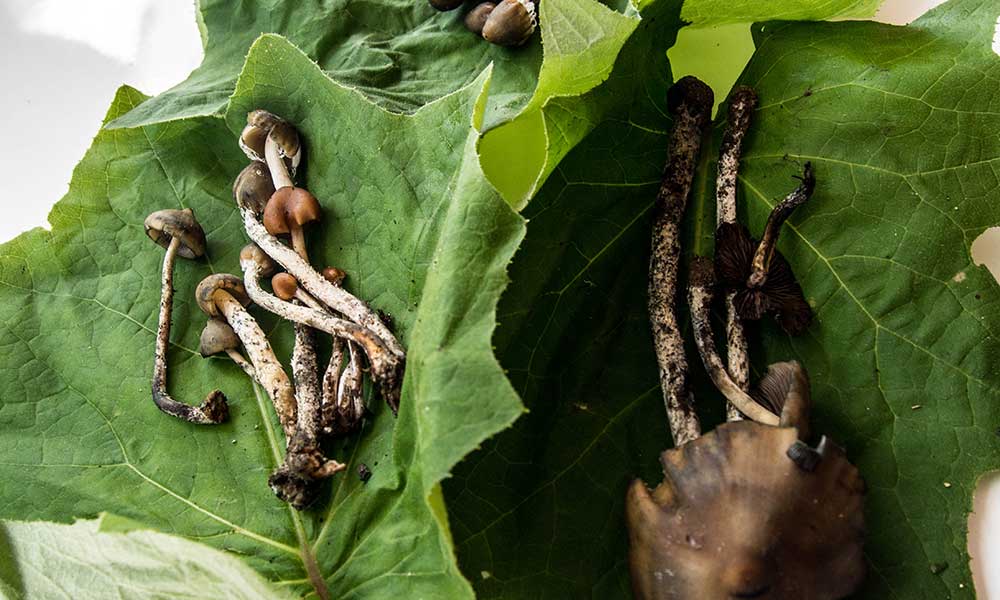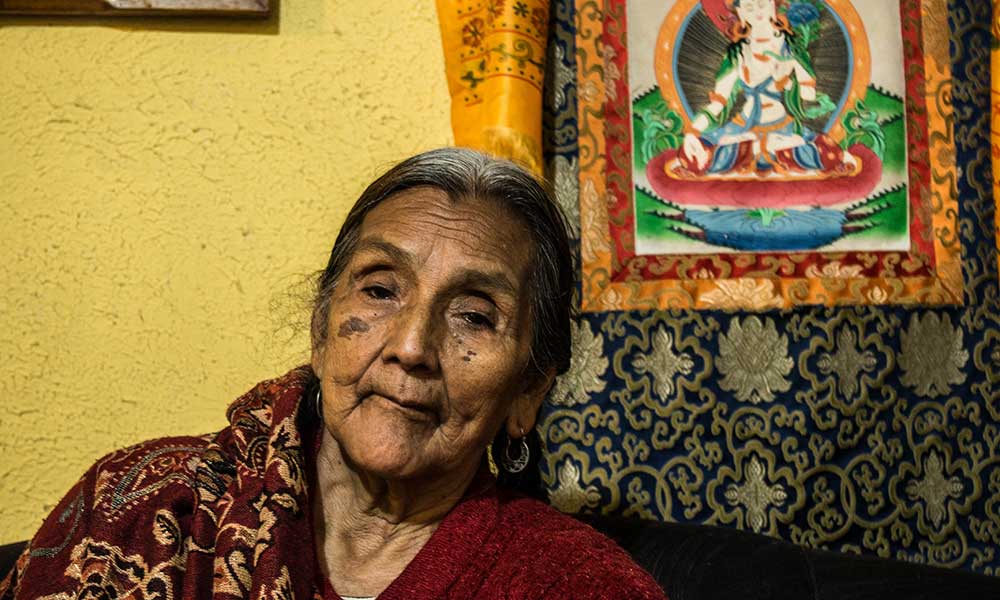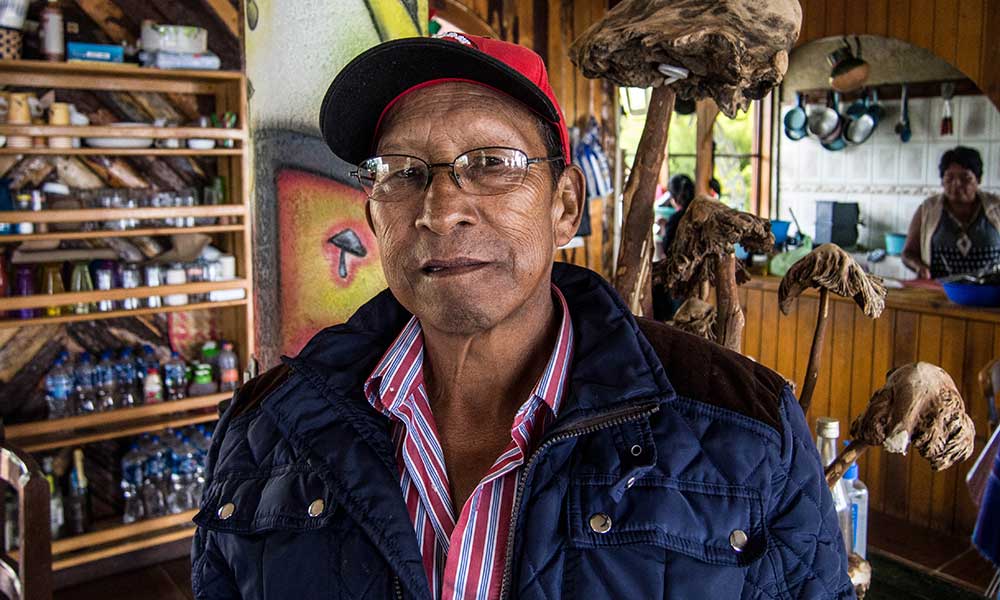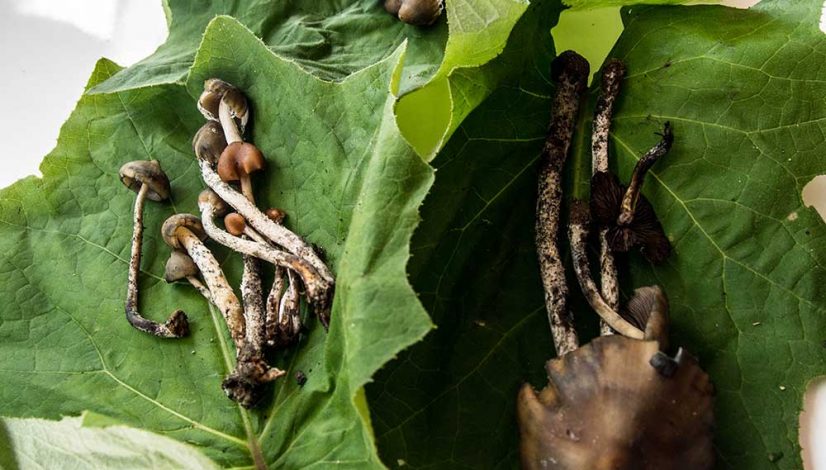Magic Mushrooms In Oaxaca
The post Magic Mushrooms In Oaxaca appeared first on High Times.
For the magic-mushroom towns of Mexico, the discovery of the fungus’s indigenous wisdom by outsiders has been a blessing and a curse, as a new hallucinogenic-medicinal tourist industry evolves in the Oaxacan sierra.
Clouds settle over the Mexican town of Huautla de Jiménez, nestled deep in the sierra of Oaxaca State; the summer rainy season has arrived. For the inhabitants of the town, rain means many things, but most of all it means that its famous mushrooms will begin sprouting up in the surrounding hills.
“The first time I tried mushrooms I was 7 years old,” Andrés García says. His grandfather allowed him to join a nighttime purification ritual in a special location a short hike outside of town called the cerro de la adoración—worship hill. It was a coming-of-age moment for a member of a clan that has lived in the region for generations.
“And each time after that was different; each time there were messages and messages. Communication with the earth, the universe, the moon, especially the energy of the moon,” García says. “The mushroom shows you everything—about your errors, your problems, all the good you’ve done, all the bad you’ve done. It’s something personal.”
García sounds wiser than his 20 years, walking around his family’s small property on the outskirts of Huautla de Jiménez. From the outside, the few scattered shacks don’t display any evidence of the famous visitors who once frequented the property to experience firsthand the sensations that García quietly describes. But one of the small buildings contains photos, clothes and artifacts from García’s famous great-great-grandmother, María Sabina, considered by psychedelic scholars as the matriarch of modern mushroom culture.

Derrumbe mushrooms, often sold wrapped in large leaves, are easy to acquire in San Jose del Pacifico.
When Sabina and the indigenous wisdom of mushrooms became known by outsiders, it was a blessing and a curse, as Huautla de Jiménez and other communities across Oaxaca saw their way of life change dramatically. In the nearly 70 years since then, an increase in tourism and economic prosperity has also brought a wide range of other problems to the mushroom towns of Mexico.
The documented use of mushrooms in indigenous Mexican ceremonies goes back to early texts from Catholic friars who accompanied Spanish conquistadors in the early 1500s. Appalled by what they saw, the conquistadors attempted to suppress the rituals, forcing the communities to operate in secret for hundreds of years. Eventually, scholars incorrectly identified the indigenous word teonanácatl as peyote (another indigenous Mexican psychotropic), until in 1936 a Mexican ethnobotanist, Blas Pablo Reko, uncovered the possible existence of mind-altering mushrooms. He published a paper identifying teonanácatl as a specific mushroom, but it remained largely ignored for nearly 20 years.
The turning point came in 1955, when an American, Gordon Wasson, along with photographer Allan Richardson, participated in a velada—a nighttime mushroom purification ritual. Wasson had spent several years visiting Huautla de Jiménez after reading Reko’s paper, attending several veladas—but he was never allowed to participate.
However, Wasson eventually met a prominent local family who brought him to the home of María Sabina, and he finally was able to take the mushrooms. Although Wasson agreed not to reveal the identity of Sabina or the location of the town, he did both two years later in a book on mycology and a widely read article in Life magazine, detailing the sacred velada. Shortly thereafter, there was frequent knocking on Sabina’s door.
In the following years, celebrities like John Lennon and Bob Dylan participated in veladas with Sabina, as did Albert Hoffman, the famed LSD scientist, who would later identify and synthesize the mushroom’s psychoactive principles as psilocin and psilocybin.
But as the fame of Sabina and Huautla de Jiménez spread throughout the West, and hippies traveled to the isolated region in the 1960s, the attention remained unwanted for much of the community. Neighbors ostracized Sabina for sharing the town’s secrets, culminating in her home being burned down by unhappy locals. It’s said that by the end of her life, Sabina regretted her role in introducing Westerners to the velada, who she thought had corrupted it.
After her death at the age of 91 in 1985, the fame of María Sabina and Huautla de Jiménez continued to grow. Throughout Mexico, Sabina’s image is plastered on T-shirts and posters sold side by side with those of other Mexican icons like the revolutionary Pancho Villa and the masked wrestler El Santo.
Today, the town of Huautla de Jiménez has fully embraced its reputation as the home of mushroom shamans. The industry is blatant: A taxi company named María Sabina has its cars roam the streets, mushrooms painted on their door panels. Market stalls sell posters with Sabina’s likeness alongside a wide variety of mushroom-themed knickknacks. Stores and restaurants bear her name.
The local municipal government has commissioned numerous murals depicting the fungus and its spiritual effects in the main plaza, and even more noticeably on the wall of the main government building, where an elderly woman’s face stares down a stormy path of mushrooms and skulls to a serene doorway.
“The mushrooms have helped the municipality, because tourism comes and it advances the economy,” says Clotilde Jiménez Figueroa, the municipality’s treasurer. “The main reason we’re a Pueblo Mágico is because of the mushrooms and rituals.”
Since 2001, Mexico has designated 111 towns as Pueblos Mágicos—“magic towns.” Most receive the distinction for their aesthetic beauty or customs. Huautla de Jiménez, a somewhat ugly village, is definitely in the latter category. This also explains why law enforcement turns a blind eye to the mushroom trade in Huautla de Jiménez and other communities throughout Oaxaca, even though it is illegal in Mexico.
“The federal government knows about our rituals here,” says Figueroa. “Up until now, they haven’t [enforced the prohibition on] selling or using because it’s a part of our culture.”
In Huautla del Jiménez, there are now several curanderos—healers—who offer midnight veladas, and perhaps none has taken the mantle from María Sabina more fully than Julia Casimiro. Doña Julieta, as she’s known in the community, sits in a small room in her house near the main plaza, in which she performs veladas. On the wall behind her hangs a banner with Buddhist iconography, although she herself isn’t a Buddhist.

Shaman Doña Julieta
“The Dalai Lama gave it to me,” she says humbly. Doña Julieta gained her own international recognition when in 2004 she was named to the International Council of Thirteen Indigenous Grandmothers, a group of prominent female elders from indigenous communities around the world who focus on prayer, education and healing for the Earth.
At 81 years old, Doña Julieta still performs ceremonies for curious foreigners and Mexicans alike, a practice which is no longer frowned upon in the community. The townsfolk have accepted their role as guides for the seekers who make the pilgrimage to Huautla de Jiménez.
“It’s the custom of our ancestors,” says Doña Julieta. “Our job now is to guide and stabilize the trip, to allow them to gather wisdom and elevate themselves to understand it.”
Doña Julieta has taught her children to lead ceremonies as well, continuing the tradition that was passed down to her. She learned the craft from her mother-in-law, and by age 17 she was leading ceremonies herself. Doña Julieta has seen firsthand how the mushroom trade has changed the community.
“When I was a little girl, it was poor here. We didn’t have television, a highway—nothing,” she says. “Now we have everything.”
She knew María Sabina, and she remembers the celebrities who came through, although she can’t remember their names. She refers to John Lennon as that “poor boy, the one who was killed.” She recalls the endless stream of foreigners coming to the town in search of mind-altering magic mushrooms, which are often referred to by locals as niños santos—holy children.
“I would meet with the foreigners secretly; we weren’t supposed to give the niños santos to foreigners,” she says. “It was dangerous to do it back then, to allow these foreigners into our culture. But it helped our community a lot.”
Jesus Perida Merino, the proprietor of the María Sabina restaurant, says he has a special connection to the deceased healer. He claims he often worked as an interpreter for the Mazateco-speaking Sabina, who didn’t speak Spanish. He fondly recalls the time he interpreted for then-President José López Portillo when he visited the community in 1980 to build Sabina a house years after hers had burned down.
“A lot of people here that could speak Spanish, they exploited her. They charged large fees to see her, and she didn’t realize it,” says Merino. “A lot of people here live off what she did, but they never gave her any money—she didn’t know.”
But even with his connection to Sabina, Merino admits that he doesn’t share any of his meager profits from his small back-alley restaurant with her family now.
At the top of the hill, Andrés García, a fourth-generation descendant of Sabina, ruminates on this issue after catching a glance at my notebook, in which I’d written the name of the treasurer.
“The government doesn’t give us anything, we make everything from giving tours,” says García. “No one gives us any money when they use [Sabina’s] name or face without permission.”
Still, he’s proud of his family’s place in the mushroom mythology of Mexico.
While García was born into the first family of Mexican mushroom shamans, his experience as a child is not uncommon to kids from several communities throughout Oaxaca.
Across the state in San José del Pacífico, a small town in the Oaxacan cloud forest, 8-year-old Hector Cruz Ramirez eats enfrijoladas after school. In the weeks to come, he’ll be eating something more exotic.
“I’m excited to eat [mushrooms] for the first time. I’ve never tried them before,” Hector says, before admitting he also feels nervous.
Several of his cousins also ingested mushrooms when they were 8 years old, as did his father and uncles; however, they haven’t told him anything about the experience. But Hector has an adventurous spirit. He says he wants to be an explorer when he grows up.
Hector’s grandfather, Leonardo Cruz Ramirez, is somewhat of an explorer in his own right: a patriarch of the mushroom scene in San José. Most of the townspeople call him Tío (Uncle). He’s lived there his entire life, and he’s helped make San José del Pacífico the town that may have usurped the magic-mushroom mantle from Huautla de Jiménez. Located in the sierra halfway between Oaxaca City and the state’s famous beaches, it’s become a haunt for backpackers.
“The mushroom culture here was very strong, but reserved. My grandparents, my ancestors, ate them, but with a lot of respect. The mushrooms were used as a medicine to cure and help people,” Tío says.
But life in the sierra was tough growing up. When Tío was a child, San José didn’t have schools or teachers, and the children worked in the fields during the day and took classes at night from an educated neighbor.
Things changed on March 7, 1970, when foreigners descended on the town in droves for a record-lasting solar eclipse (which still won’t be exceeded in duration until 2024), during which the Oaxacan sierra was the best place in the world to watch it.
“When the tourists came, we thought they were weird people,” remembers Tío, chuckling. “Men with long hair and women with pants. We couldn’t distinguish who were men and who were women.”
Many of the outsiders began asking the locals for the mushrooms normally found in Huautla de Jiménez, and the locals provided them. Until that time, foreigners had hardly heard of San José del Pacífico, but later it became well-known on the backpacker trail.
Eighteen-year-old Tío opened a small music store in town that year, catering to tourists. After saving up for several years, he bought a group of cabins nestled among the town’s hills in the mid-’90s.
His cabins, Cabañas Pacífico, and restaurant do not hide their function as a safe haven for those seeking niños santos. Murals in the restaurant depict fungi. Lights in the cabins are shaped like mushrooms. Tío runs the business with his wife of 40 years, Ofelia, and his four sons, each of whom ate mushrooms at age 8, as did three of his grandkids.
Although Tío has been at the center of the mushroom movement in San José del Pacífico for decades, not everyone in the community likes how mushroom tourism has changed the town.
Sebastian Pinacho, a local municipal representative in San José del Pacífico, is from one of the town’s oldest families. He estimates that of the 800 townspeople, about 400 trace their roots to the Pinacho family.
“There’s good tourism that comes, but also bad tourism: drug addicts, people that just want to get high,” Pinacho says.
He admits that San José is in a better financial situation than other towns in the region because of the mushroom tourism, but Pinacho felt directly affected from the influx of drugs after his son became a crack addict. He says that the community had never seen drugs beyond mushrooms before outsiders started arriving. For him, mushrooms are a gateway to the harder stuff.
“They say mushrooms aren’t a drug. But if it’s not a drug, why are these people coming? Why are they seeing things that don’t exist?” Pinacho asks, sitting in his office.

Tío owns a small family restaurant decorated with mushroom sculpture sand paintings.
The town recently saw a minor scandal erupt when an Australian arrived in town and began dealing not just mushrooms, but allegedly other drugs. Residents didn’t take kindly to the intrusion, especially a local mystic named Navarro.
Navarro animatedly recounts how he threatened the foreigner with a machete after he’d sold non-hallucinogenic mushrooms to tourists.
He considered it a great injustice to the town, and more importantly, to its niños santos. Navarro stresses the importance that mushrooms play as a medicine, and how San José has become a sanctuary for this form of healing.
Navarro proudly explains the three main types of hallucinogenic mushrooms common in the region: San Isidro, Pajaritos and Derrumbe. He discusses the varieties of trips, and says that each would be better after a ritual in a temazcal—a Mesoamerican steam lodge.
Navarro’s small cabin is located a few kilometers down the highway from San José. He says he built it with his own hands, along with the four temazcal huts that sit outside. Here he offers an age-old purification ceremony for curious tourists.
“This is one of the few places in the world where you don’t have to talk; you have to feel,” Navarro says about the temazcal. “When you leave it, it’s a rebirth. You see better, you listen better. It’s the womb of Mother Earth.”
During my visit, two South Korean backpackers decide to take Navarro up on his offer. Kim and Nancy came to San José unaware of its reputation as a mushroom getaway, but after finding out, they want to give it a try. They agree to be followed while they try mushrooms for the first time, but only if their real names aren’t used. For good reason: South Korea infamously has prosecuted several Korean celebrities and tourists in the last decade for drug use overseas after they were caught on social media.
We arrive at Navarro’s cabin for a morning ritual. Inside the temazcal, Navarro has placed several scorching-hot stones; outside, a special tea of wild herbs boils over a small fire. We enter the hut, and Navarro periodically brings us refills of the steaming mixture, encouraging us to dip leaf-covered branches into it and then place them on the stones. He believes that having participants administer their own ritual enhances their experience. We perform this repeatedly for 45 minutes as steam fills the dome-shaped structure.
“It felt beautiful—I feel cleaner, different, like a new me,” says Kim afterward, sitting on Navarro’s deck covered in sweat. “But now let’s go to another world.”
We drink a tea made from the mushrooms, eat the fungi, and walk into the woods. As we drop into the trip, I watch Kim lie on her side as Nancy begins meditating and softly sobbing.
Later, back at Tío’s cabins, Nancy reflects on her trip.
“I was having a tough time in my life, but I couldn’t do anything. I needed something to help, and people told me to try meditating. It helped a bit, but not enough,” she says. “Today was totally different. I felt the third eye.”
“I don’t believe in God, but I met someone, I went to some special place, like heaven,” Nancy says. “I feel I’m changed. Before, when I took some other drugs it made the world a bit different, but this time I’m different. I’m changed.”
I’ve felt changed by my own mushroom experiences many times in the past, but with Kim and Nancy I feel different, as if for once I am a guide, watching the medicine change others. The afternoon brings heavy rains to San José del Pacífico, and both Kim and Nancy place their hands in the downpour, sprinkling water on their faces, appearing rejuvenated.
I ask them if they’ll try it again.
“Definitely,” they respond, smiling.
The post Magic Mushrooms In Oaxaca appeared first on High Times.


